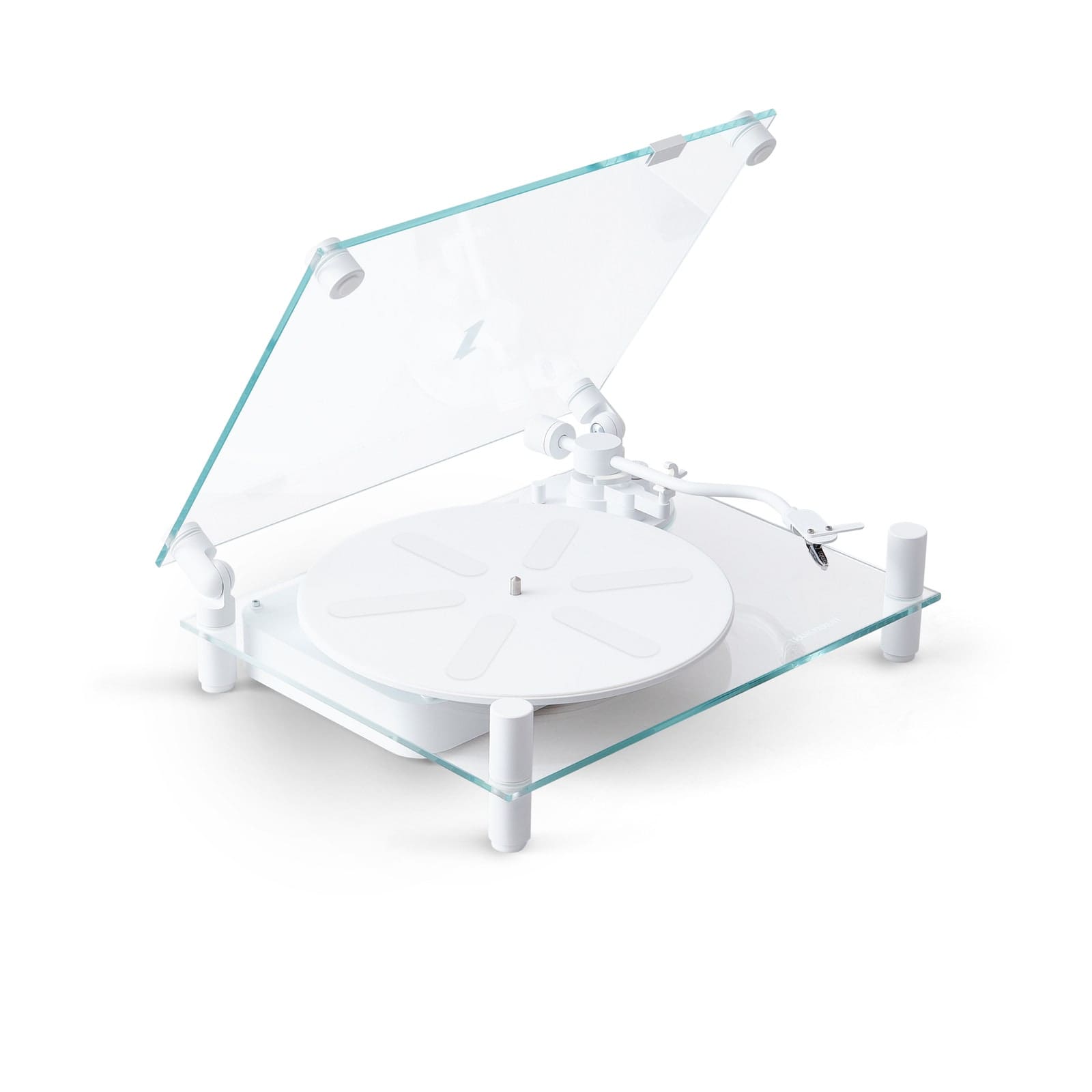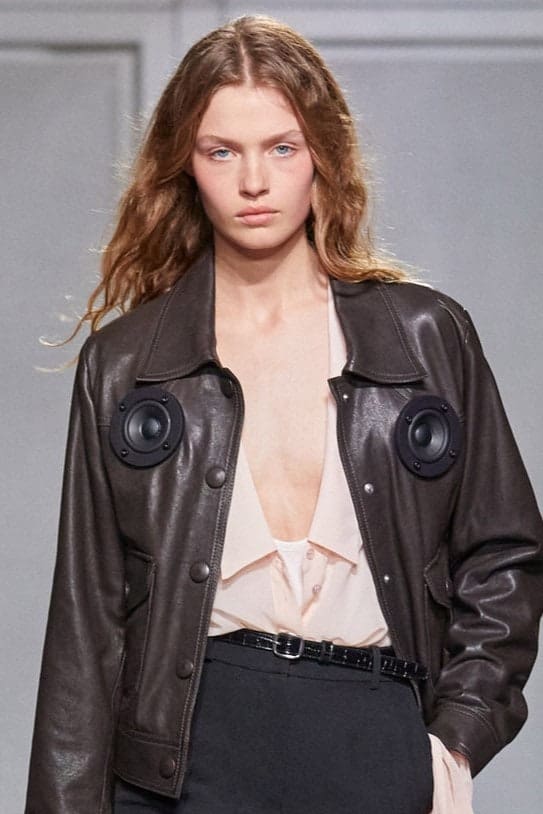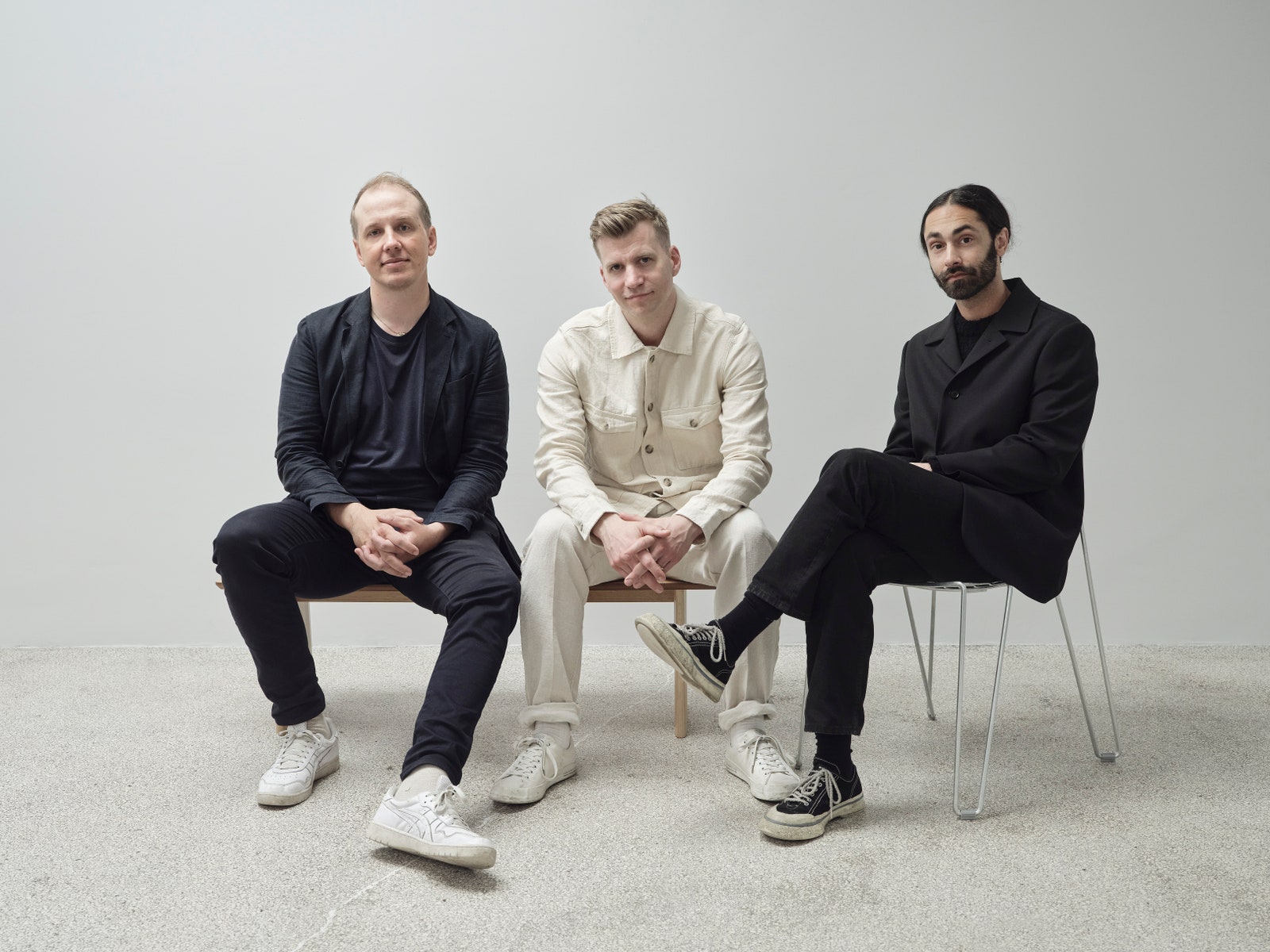The Coperni x Transparent speaker jacket for spring 2024 Photo: Courtesy of Coperni
Sweden, home to companies like Spotify, Ericsson, and Klarna, is a leader in tech innovation. Now Transparent, an independent business focused on well-designed, responsibly made, adaptive sound equipment, is building bridges with fashion. It is Transparent that collaborated with the Paris-based label Coperni on its first-of-its-kind spring 2024 speaker jacket. And on December 6, the company will release 19 hammered-steel speakers at the online retailer Mr. Porter.
Founded in 2014 by Per Brickstad, Magnus Wiberg, and Martin Willers, Transparent’s stated mission is no less than “to become the first circular tech brand.” The company name refers to not only the trio’s operating practices and philosophy but also their aesthetics. Working mainly in aluminum and glass, Transparent’s founders have focused on a modular approach to design and functionality. Clear products fade into interiors, which gives them a timeless quality, and technological upgrades can be addressed by changing out a single part of a sound system, keeping the whole from becoming obsolete.
It was Sarah Andelman of Just an Idea (and formerly of Colette) who made the introduction between Coperni’s Sébastien Meyer and Arnaud Vaillant and Transparent. The French duo is preoccupied with sonics and wanted to marry a sleek design to a technically advanced and integrated individual sound system. This way the wearer can project their universe by appealing to more than one sense. “It’s easy to make something look like a speaker jacket,” notes Brickstad, “but to actually make something that works and sounds good, that takes some more work.”


The Transparent team is always thinking about how to better live with sound and, more recently, about what Wiberg calls “nostalgic rituals.” It seems they are not alone, as they’ve charted a growing interest in turntables among young people. It’s about going into “a more focused state of mind,” says Brickstad. “Playing a vinyl record is a countertrend or counterforce to this quick consumption. You want to go to something more profound. Our followers and customers who are young are discovering this format for those reasons. It also has to do with time, in a way. We try to do something again that is retrofuturistic in [design but that also] can make you disappear for a moment and be in that ritual for a whole record.” Will wearables be able to do the same thing? We don’t know the answer yet, but we’ll never get there without trying.
Vogue: How did the Coperni project come about?
Per Brickstad: Sébastien and Arnaud came to us. They wanted to do a jacket with speakers. They had a pretty clear idea of the sort of piece that they wanted to represent the whole collection, which was so much about music, culture, and this sort of retrofuturistic thing that ties into what we do a lot. They had these sketches and our products on their mood boards already.… We had a meeting last summer; it was super quick, [with a] super-short lead time. Luckily, given the modularity of our products, we were able to reuse components from our product range.
Magnus Wiberg: It takes around three years for us to develop a new product, to create a speaker, so it’s a long process. That is a normal lead time, and [that he was able to do this so quickly] is what makes Per brilliant.

What were the design considerations you faced?
Brickstad: The designers had their idea, but I was thinking, How can we do this in a way that is not just a gimmick but that works? It’s easy to make something look like a speaker jacket, but actually making something that works and sounds good takes more work. We had some intense weeks of 3D printing because the jackets were size 32 or 34, super small.
Wiberg: You need to dive into how this can be comfortable for the end customer but also have this power. You need to go into a different mindset.
Brickstad: How does it hang on your body? How does it work? There’s so much to take into account. I had to do a very organic inside-of-this-speaker-cabinet 3D-printed internal acoustic chamber. So inside the jacket, the speaker is very flat but still has sufficient acoustic volume—to make something sound great, you have to have a certain volume of air—and follows the body of the person who wears it. By doing that, we were able to accomplish decent sound. You also need to have a battery and an amplifier. We put those in the pockets and let the cables go through the back. It was a challenge, but we pulled it off in the end.
Why blast music out of your clothes?
Brickstad: When I was younger I always had a portable speaker around my neck when traveling, like a walking sound system. And wearing the Coperni jacket is a little bit like that. You’ll be the center of the party in a way. We realized from wearing and using this jacket that vibrations actually come through your whole body. So it’s not only hearing, it’s like, Wow, I’m immersed in the center of this sound experience. We were a bit surprised about the feeling of wearing it, actually.
Wiberg: We got really, really happy. We talk quite often about an immersive sound experience, and this can definitely be one part of it.
Brickstad: There’s a term called transparent sound in the technical audiophile world, which means the sound you hear gives an authentic reproduction of the recording. So staying true to an artist, that actually is a term, that it’s transparent…. In the same way that we blend into an interior, we want to channel the true intention of a musician because people care about the music. People love the music, obviously, and we want to put people as close as possible to that experience. And the jacket was surprisingly an example of that—being close to the music.
By putting this technology onto your body, do you become one with the machine in a way?
Wiberg: We are sort of already in the cyborgian age…. It feels so natural that our second skin—clothes—would be able to help us a bit more. [Clothes] should not only be an expression but could also have another purpose, and perhaps it’s time now to spark that.
Brickstad: In all art forms—be it painting or poetry or fashion, everything that has a deeper thought behind it—it’s possible to convey a deeper message through a sort of shallower surface, just by the fact of being a human voice speaking to another human’s ear. You have a sender, and you have someone receiving it. It can be very subtle, and it can be so much information that we will never know about. As long as that is a human sender, even though it has cyborg-like ingredients to it, it has the possibility to land well in terms of being a profound experience. We get so bombarded and drowned by all these expressions, so what can be a profound experience these days when everything is just shallow, shallow, shallow?
Wiberg: It’s so hard to be a designer. It doesn’t matter which field you are in because the end customer is so much more here in what they can see of images and they think we can just create everything. And so they are here, and we might be elsewhere in that process. Once again, it doesn’t matter really which industry you are in. How can you really push those boundaries?
Brickstad: Human expression will always transcend those boundaries because we’re human. Until people put robotic PCBs in my head, we are going to be human.
Can this Coperni x Transparent project tell us anything about the future of fashion and technology?
Wiberg: We don’t really know where that will go. In this collaboration, we didn’t think about the long-term.
Brickstad: For me, it’s being sure that we use a modular approach and we have our design philosophy about repairability, reusability, in that context. As long as we can preserve that, the jacket can turn into a sculpture in 10 years as long as we don’t glue everything together like everyone does and then cover it with a fancy surface.
You have to do something for the right reason. We have this foundation that we do things with, and then we have to be humble about where [the ideas] take us. There’s too much nervousness about being absolutely 100% correct from the beginning, and you don’t dare to make mistakes, you don’t dare to go out there and [say,] “We believe in this, and we’ll try it, and if it fails, we’ll learn.” That is something in our philosophy: to be able to go towards the goal, not to own the goal day one, basically.
Will they produce the jackets?
Brickstad: They might. We have said we do maximum this amount because we can’t mass-produce it.
Wiberg: It’s hard to say how many, but we have to set the maximum. But it’s not a showpiece. That has also been very important for us, that this is actually something people can purchase.
Finally, why do you think Sweden is an innovation leader?
Brickstad: It comes back to the collaborative nature of Swedish culture, the sort of democratic heritage we have, the functionalistic and collaborative heritage. You can go to a design school and compare it with an American school, for example, or a British school; you see so much competition, and people are locking their sketches into a cupboard and protecting it with their lives. But in Sweden it’s all about collaboration.
Wiberg: And also that education is free.
Brickstad: It’s not only about technical innovation. Talk to [music producer] Max Martin or whoever is in the Cheiron Studios behind all these hits—it’s also about collaboration. They’re also talking about the fact that it’s not being too precious about your own idea but actually being able to collaborate.
Wiberg: When they talk about ABBA, part of their success is their sort of bittersweet recipe. It’s not only the tones that are happy. Like the black and the white tones on the piano, [their songs] go from a happy chord to a bit of a sad vibe, but then it’s happy again. And that is an aspect of Swedish culture—we have the darkness. We have this welcome-to-Sweden melancholia. Embracing humanity or imperfections [and putting them] into a happy context, [into] a product that is not just surface but has a soul and something deeper—that might be part of it.

This article was originally published on Vogue.com
